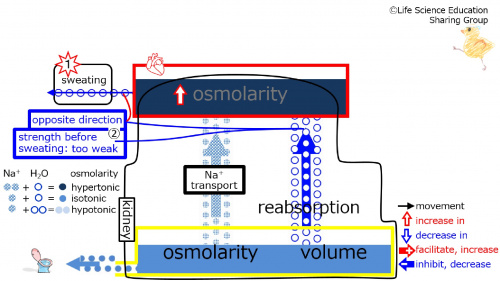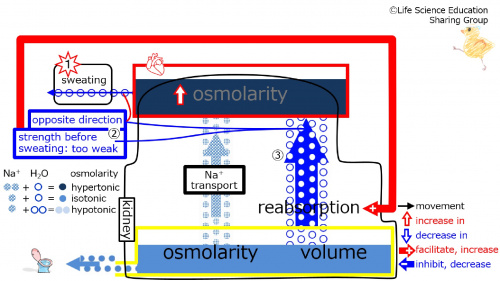SHolroydAtWeilCornellMedQatar/Urology/Kidney/Tubules/WaterReabsorption/ControlToSweating
| With sweating, the plasma osmolarity increases and negative feedback increases the synthesis, secretion, and blood concentration of vasopressin (anti-diuretic hormone, ADH). |
Prior to sweating (at baseline), we will make the assumption that the subject is in homeostasis with normal plasma and urine osmolarities (isotonic) and volumes.
Step 1: With sweating, water leaves the plasma and osmolarity increases (the plasma becomes hypertonic).
Step 2: With reabsorption (through the water channels, which are increased by vasopressin, ADH), water enters the plasma and osmolarity decreases. This is the opposite effect of sweating. Thus, with the high plasma osmolarity produced by sweating (hypertonic plasma), the baseline strength of the plasma osmolarity-decreasing effect of reabsorption would be too weak. Control by negative feedback is needed.
Step 3: With the baseline effect of the reabsorption (through the water channels, which are increased by vasopressin, ADH) being too weak, the negative feedback increases the synthesis, secretion, and blood concentration of vasopressin (ADH).
Step 4: The water channel-increasing effect of vasopressin (ADH) increases, thereby increasing the number of water channels. This increases the reabsorption of water by the kidney.
Step 5: The ratio of Na+ to water entering the plasma due to reabsorption decreases. This decreases plasma osmolarity. This will lead to a decrease in the increased plasma osmolarity from sweating (hypertonic plasma), returning it towards normal (baseline) osmolarity (isotonic plasma). Because a lower ratio of Na+ to water leaves the tubule due to reabsorption, the fluid remaining in the tubule has a higher osmolarity (hypertonic). Also, with an increase in water reabsorption, there is less water remaining in the tubule. Overall, the urine becomes more concentrated (hypertonic) and lower in volume.
Challenge Quiz
With sweating, negative feedback increases decreases the synthesis, secretion, and blood concentration of vasopressin (anti-diuretic hormone, ADH).
With sweating, negative feedback increases decreases the number of water channels in the kidney.
With sweating, negative feedback increases decreases water reabsorption by the kidney.
With sweating, negative feedback increases decreases urine volume.
With sweating, negative feedback increases decreases urine osmolarity.
With sweating, negative feedback increases decreases plasma osmolarity.
With sweating, the plasma osmolarity decreases increases . The effect would be the same as opposite to that of reabsorption of water by the kidney, which decreases increases plasma osmolarity. The effect of the reabsorption would be too weak too strong prior to control by negative feedback. Negative feedback increases decreases the synthesis, secretion, and blood concentration of vasopressin (anti-diuretic hormone, ADH). This in turn increases decreases the number of water channels in the kidney causing increased decreased water reabsorption. Urine osmolarity increases decreases while volume increases decreases . This decreases increases plasma osmolarity, returning to normal separating from normal .




